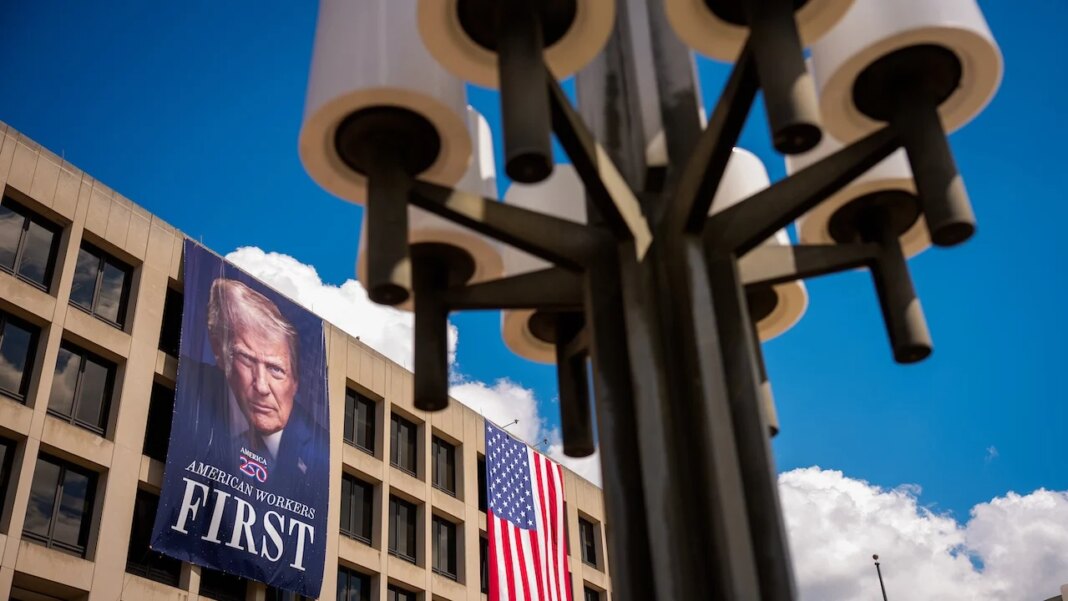Shifting Narratives: The U.S. Labor Department’s New Focus on White Male Workers
In a notable pivot, the U.S. Labor Department is redefining its communication strategy, particularly on social media. The new messaging emphasizes a demographic that many critics believe does not represent the nation’s workforce: white males. This strategic shift has ignited discussions around workplace diversity, the portrayal of American workers, and the socio-political motivations behind such a move.
The New Messaging Strategy
Recent publications highlight that the Labor Department is increasingly showcasing images and slogans centered around white men, diverging from the previous approach that celebrated a mosaic of racial and gender diversity. Posters featuring slogans like “Your Nation Needs You!” and “Build Your Homeland’s Future!” prominently display white male workers in front of iconic symbols like the Statue of Liberty. This pivot is not merely about imagery; it reflects a broader narrative that seeks to resonate with a specific audience in a polarized labor market.
The Rationale Behind the Shift
Proponents argue that this focus is a push to prioritize American citizens for job opportunities over foreign workers. The intent is framed as a means to bolster the national workforce, support local economies, and reinforce the identity of American labor. Labor Department spokeswoman Courtney Parella addressed the shift, challenging critics who accuse the agency of excluding diverse representations. She asserted that the poster campaign is a celebration of American workers rather than a racially charged narrative.
Criticism and Concerns
Despite the Department’s defense, the backlash has been significant. Critics have pointed out that the messaging doesn’t accurately reflect the diversity in today’s workforce, where women make up nearly 47% of employed individuals and various minority groups represent substantial portions of the labor pool. Judy Conti from the National Employment Law Project described the campaign as a “loud trumpet,” signaling a stark favoritism towards white male workers, thus alienating a broader demographic that contributes significantly to the economy.
The Implications of Visual Representation
Renee Hobbs, a media literacy professor, draws a connection between the Labor Department’s strategy and classic propaganda techniques, highlighting how the campaign activates strong emotions while oversimplifying complex issues. The reliance on images of white males in prominent roles not only sends a message about who is deemed worthy of recognition but also raises questions about inclusivity in labor discussions. Hobbs articulates the surprise at this shift, especially when modern media often leans towards multicultural representation.
A Broader Workforce Perspective
To understand the Labor Department’s new narrative fully, it’s essential to consider the statistics that illustrate the current workforce makeup. According to 2024 federal labor data, the percentage of Black or African American workers stands at 13%, while Hispanic or Latino employees constitute approximately 20% of the total workforce. This demographic data starkly contrasts with the Labor Department’s recent focus, underlining the discord between representation in imagery and the actual diversity of American workers.
The Political Landscape and Stakeholder Reactions
The implications of this narrative shift extend beyond workplace demographics. Many see it as a reflection of broader political ideologies that resonate with certain voter bases. By foregrounding images of white men, the Labor Department seems to be aligning itself with perspectives that prioritize traditional American values over inclusivity. This dynamic has spurred further debates among stakeholders about the direction of labor policy and representation in public messaging.
Conclusion
The U.S. Labor Department’s new focus on white males in its social media campaign has opened a complex dialogue about diversity, representation, and the underlying motivations that shape our understanding of the American workforce. As this narrative unfolds, it will be interesting to observe how it influences perceptions, policy, and the future landscape of labor in the United States.



